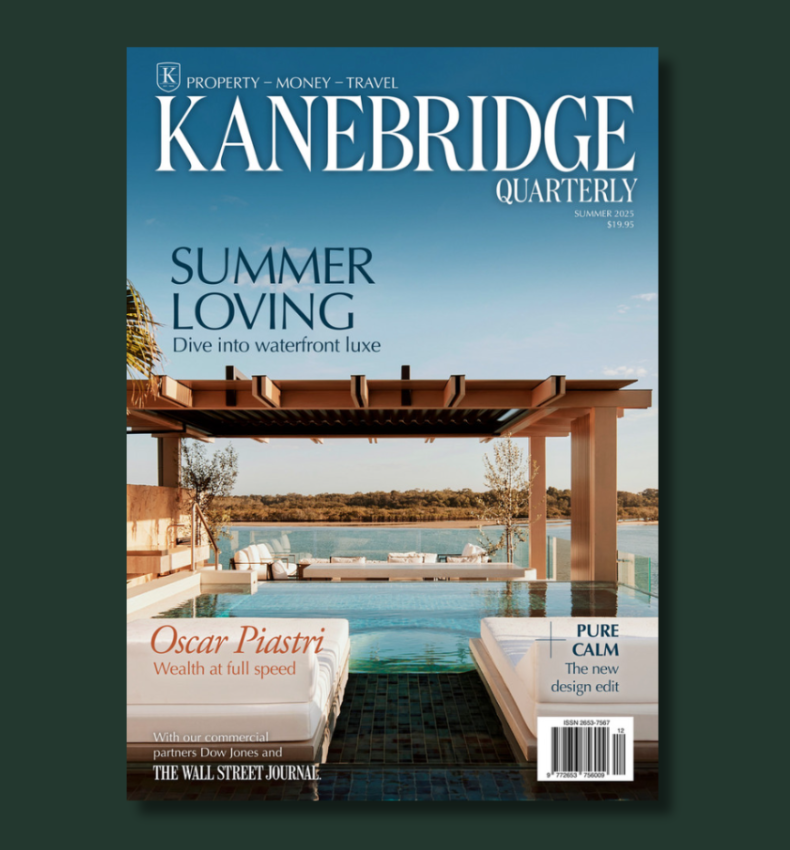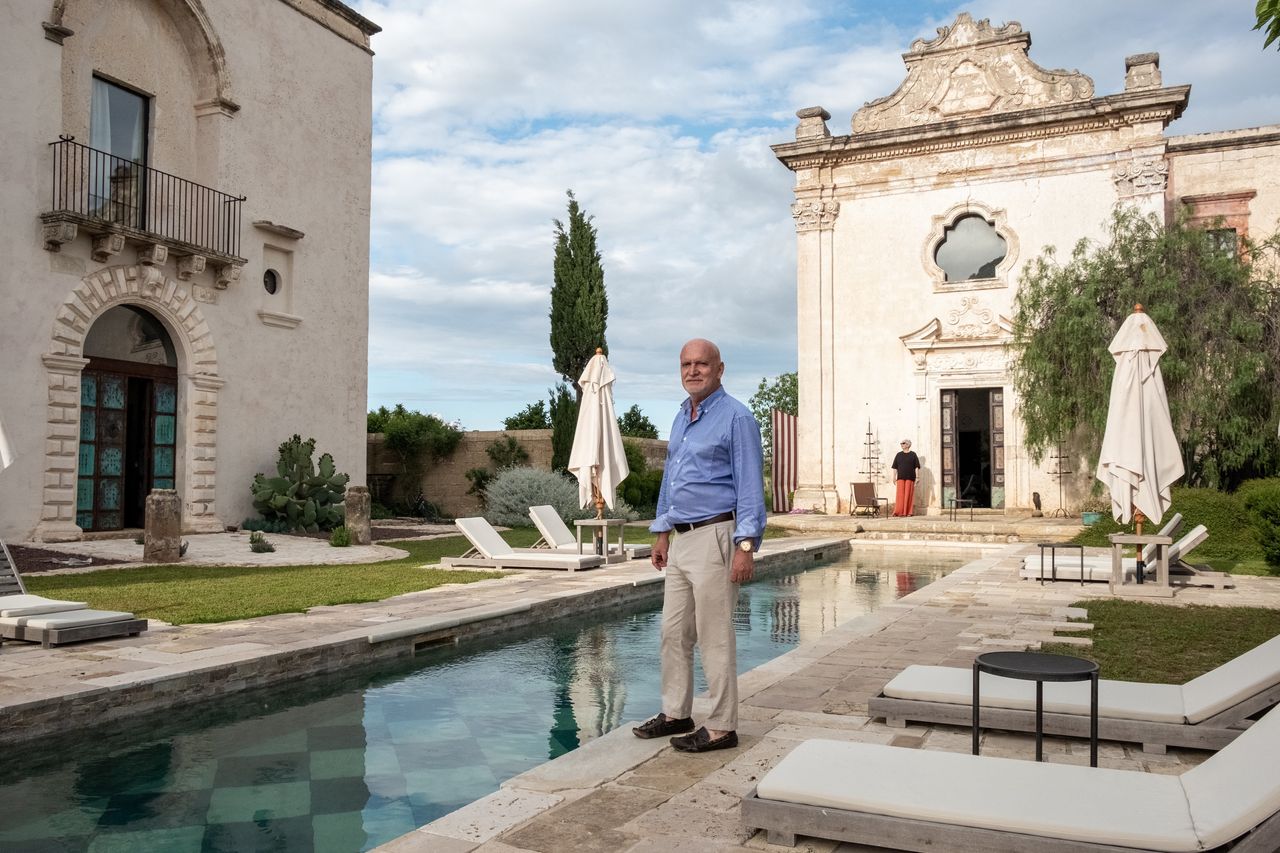Wealthy Buyers Are Turning This Region Into One of Italy’s Hottest Home Markets
Once an impoverished area, Puglia has seen an influx of high-end buyers willing to spend millions on historic farmhouses and villas
In a shaded spot near his new swimming pool, Northern Italian architect Paolo Genta is taking stock of his Southern Italian dream project—a luxurious vacation compound, serving three generations of his extended Turin family, that he created in Puglia, the region running down the heel of Italy’s boot.
On a hot spring day, over a glass of local rosé wine and tomato-and-pasta canapés, Genta, 64, remembers his initial encounter over a decade ago with the sunbaked property, which he bought in stages between 2012 and 2015, for $537,400, and then restored up through 2022.
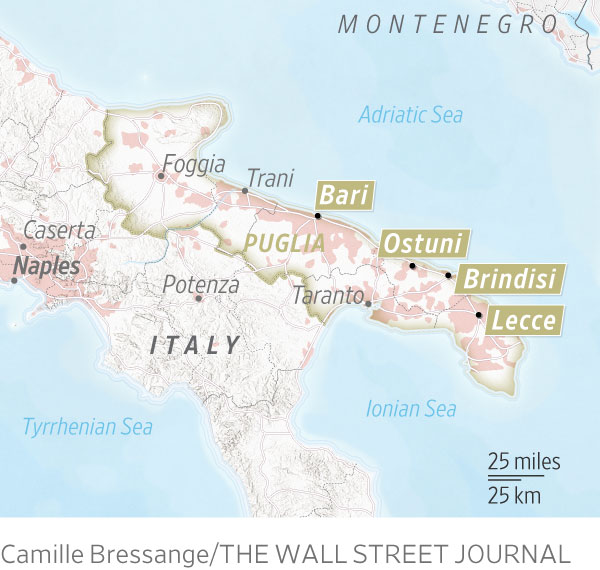
“A friend took me here,” he says, of the 2/3-acre estate, then in ruins. “But it immediately felt familiar to me—as if I already knew it.”
He has gone on to spend around $1.075 million to realise his vision by renovating three adjacent structures, dating back to at least the 18 century, as well as $236,400 on the lavish landscaping. He and the Genta clan plan to use the compound’s seven bedrooms, spread over two buildings, up to a few months a year. The third building, a deconsecrated Baroque chapel, is the perfect place to have a cool lunch on a hot day.
Genta is one of a growing number of luxury-minded homeowners who are transforming Puglia, once a remote and impoverished corner of Italy, into an outpost of upscale living. Historical stone farmhouses, called masserie, are getting high-tech upgrades, while Puglia’s traditional cone-topped rural structures, called trulli, are being converted into high-end primary suites.
Puglia is one of the few areas of mainland Southern Italy—along with the Campania region, home to Naples and the Amalfi Coast—to develop a reliable luxury real-estate sector. According to Idealista.it, the Italian residential real-estate site, home prices here now average about $121 per square foot, which is higher than in nearby Basilicata, Calabria and Abruzzo.
Luxury properties are clustered in two areas. One, Valle d’Itria, is an agricultural valley between Bari, Puglia’s largest city, and Ostuni, an old, atmospheric hilltop town. This is ground zero for Puglia’s trulli legacy. Thousands of the structures, large and small, mark the hilly countryside, creating a distinctive, rustic skyline. Further south, around the Baroque city of Lecce, lies Salento, where Genta has his compound. Flatter and hotter, with simultaneous access to both Adriatic and Ionian beaches, Salento offers more seclusion.
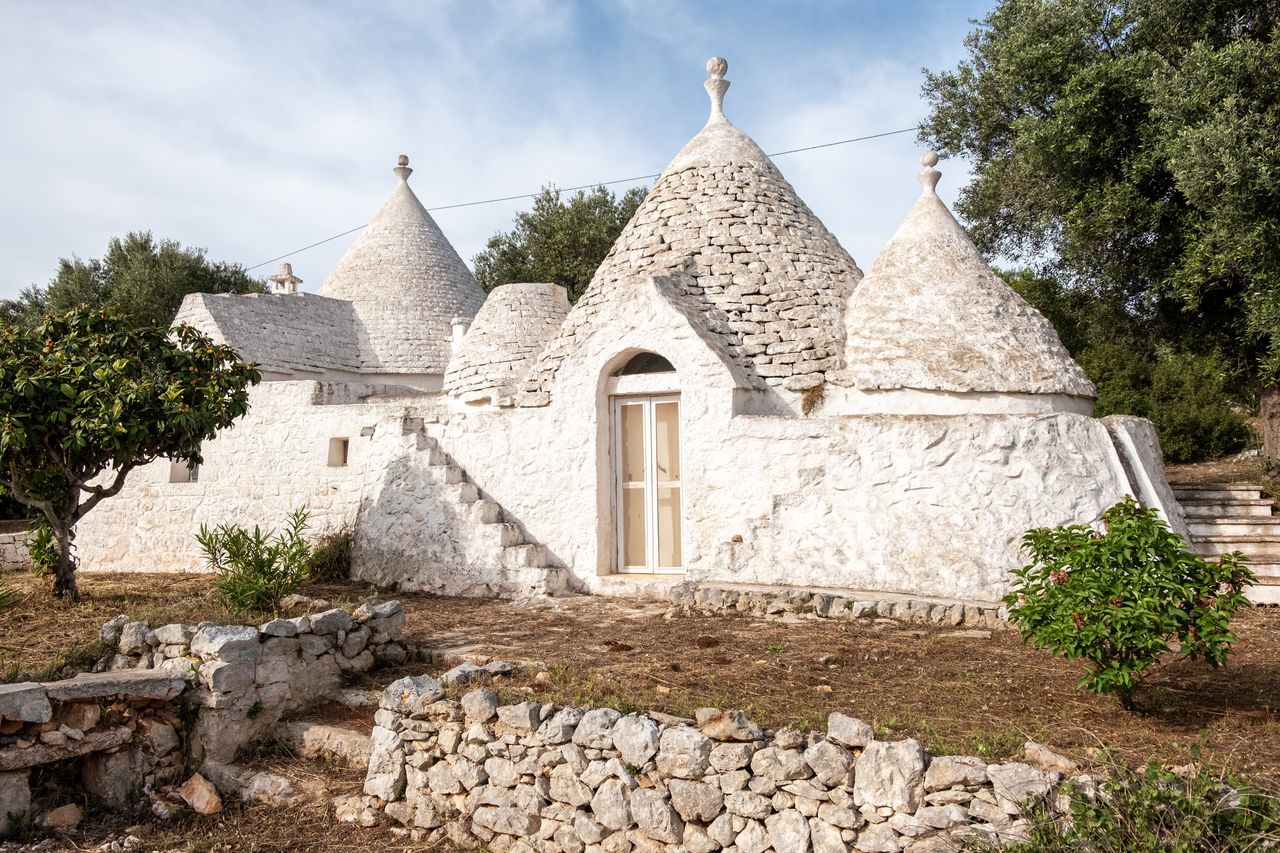
According to Idealista, Puglia’s Brindisi province, which includes much of Valle d’Itria, is seeing the region’s strongest price increases, up 9.2% between May 2022 and May 2023. The most expensive sale in 2022 was a 6,500-square-foot Salento masseria, not far from the Genta compound, which sold for $3.78 million.
Valle d’Itria is known for its white-stone towns and exclusive hotels, such as Borgo Egnazia, a 40-acre coastal resort, where high-season prices can reach $26,585 a night. Near Ostuni, a restored, trulli-topped stone house dating back several centuries has an asking price of $1.72 million; the five-bedroom home sits on a roughly 7.5-acre lot.
Valle d’Itria appeals to design royalty, such as Milan’s MariaCristina Buccellati, who works with her family’s luxury jewellery label, now owned by Richemont. Salento, meanwhile, attracts Hollywood royalty; local homeowners include actress Helen Mirren and her husband, director Taylor Hackford. In Salento, near the very bottom of the heel, a restored 12-bedroom castle, with a large enclosed garden, has an asking price of $3.56 million.
Canadian couple Alper Ozdemir and Cynthia Liu, who arrived in Puglia from Toronto in late 2021, have bought in the heart of Valle d’Itria. The active retirees, both in their early 50s, left behind Ontario’s cold climate for Puglia’s good food, warm weather and close-to-nature lifestyle, says Ozdemir.
In February 2022, they closed on a 7.5-acre farm with a trulli-topped ruin. They paid $247,000 for the property, and plan to spend about $860,000 to turn the 3,850-square-foot structure into a two-story, three-bedroom home, built around a new swimming pool.
Like many luxury buyers in the area, the couple narrowed their choice between Valle d’Itria and Salento, settling on the former. “Salento is nice in the summer,” says Ozdemir, “but people live around here year round.”
Puglia overall has become increasingly accessible. It is now part of Italy’s high-speed train network, and it has two international airports. Staying in a local rental to oversee their renovation, Ozdemir and Liu plan to use their new home, set to be completed in 2024, as a base for exploring the country.
A new set of buyers from the San Francisco Bay Area, brothers Mark and Peter Alwast, also regard their 2-acre Valle d’Itria homestead, purchased for $355,000 in September 2022, as a convenient toehold, with plans to explore Europe. The brothers, along with Peter Alwast’s life partner and Mark Alwast’s husband, expect to spend about $322,000 to renovate a 3,000-square-foot house for their retirement.
Meanwhile, they will use it as a vacation home. Despite the far longer travel time, the foursome view it as an alternative to Northern California wine country. “In Puglia you get a lot more for your money,” says Mark Alwast, 60, a designer.
Patience is often required from buyers in Puglia. Genta needed to piece together his compound from eight different owners, with some holding out for years. Retired New York attorney Ellen Bonaventura, 62, has spent the past nine years putting back together a Salento palazzo, a 30-minute drive south of Lecce, from a cluster of disparate buildings. “It was always my dream to have a house in Italy,” says the full-time Puglia resident, who estimates that she has spent $495,000 on real estate, about $3.22 million on renovation costs and around $537,000 on furniture and art, including Neapolitan and Sicilian antiques.
To-do lists tend to grow for this new round of Puglia homeowners. In 2021, Paolo Colombo, an architect based in Lugano, Switzerland, paid $1.94 million to buy two multi trulli structures on a 3.7-acre hilltop Valle d’Itria property, and then spent $2.16 million to renovate the two buildings—which required disassembling, cleaning and reassembling the massive stonework. Completed this June, the renovation will be followed soon, says Colombo, by a free-standing, latticework yoga studio and new outdoor sleeping areas, which will give his family of five a total of eight bedrooms in the main house.
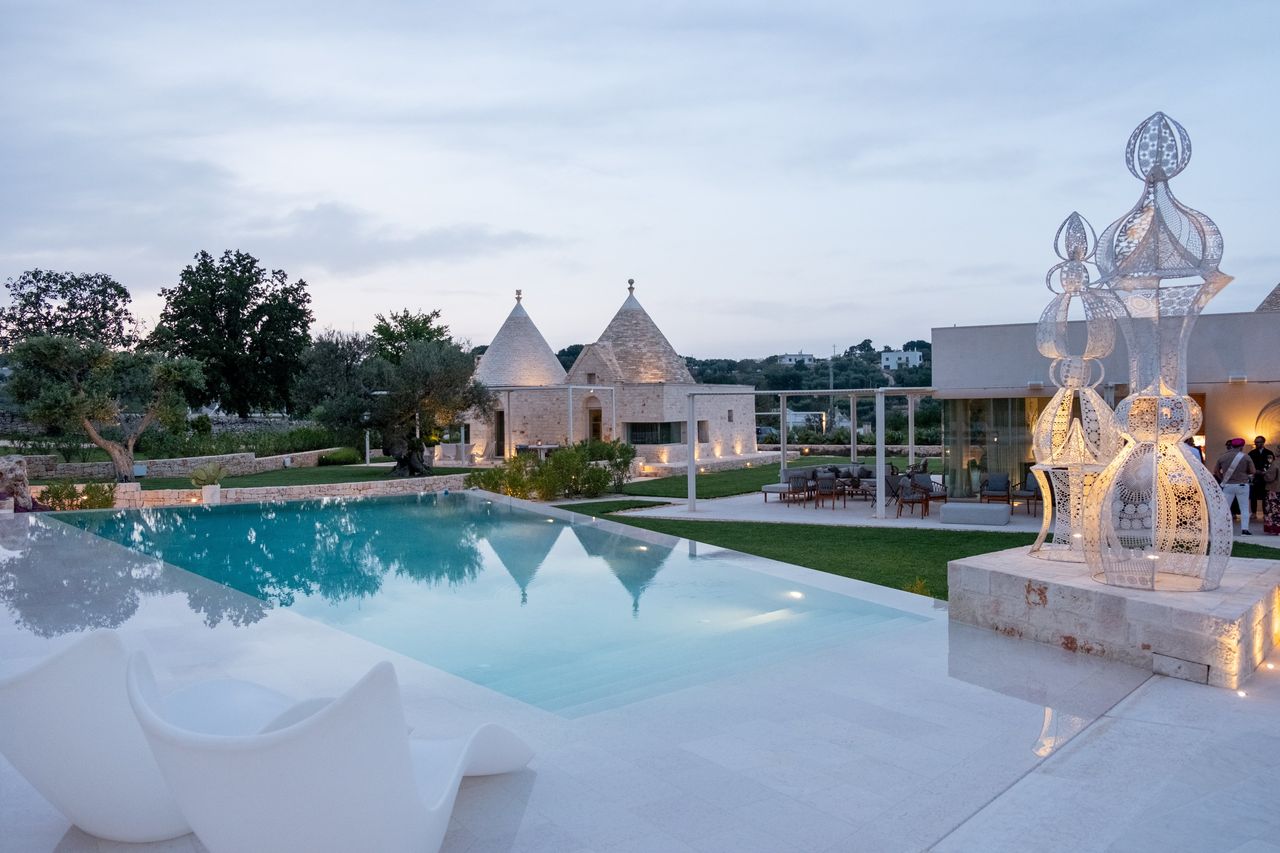
Rula Al Amad and James Woods, a Milan-based, Palestinian-American couple, have expanded their Puglia portfolio. Valle d’Itria pioneers, they started in 2006, when they paid a mere $129,000 to buy a derelict set of trulli, then spent $295,000 over the following several years to create a 2,000-square-foot vacation home.
Sensing it had become too small for their family of four, the couple paid $537,000 in 2018 for a nearby derelict masseria. They then spent about $1.57 million on a gut renovation, which wrapped up this spring. The finished compound can comfortably sleep up to 10.
Speaking in her new living room, which emphasizes the 500-year-old masseria’s use of historic local limestone, Al Amad, who first stayed in the house this past Easter, is looking ahead to winter. “We go to Michigan at Christmas but come back to Italy for New Year’s,” she says of the routine of her Midwest-born husband and their two teenage boys. “I can see doing a big New Year’s Eve party here.”
 Copyright 2020, Dow Jones & Company, Inc. All Rights Reserved Worldwide. LEARN MORE
Copyright 2020, Dow Jones & Company, Inc. All Rights Reserved Worldwide. LEARN MORE
The PG rating has become the king of the box office. The entertainment business now relies on kids dragging their parents to theatres.
From farm-to-table Thai to fairy-lit mango trees and Coral Sea vistas, Port Douglas has award-winning dining and plenty of tropical charm on the side.
The PG rating has become the king of the box office. The entertainment business now relies on kids dragging their parents to theatres.
There’s one reliable group of moviegoers left in America—and they can’t go to the movies by themselves.
This week, the kids who make up the industry’s target audience will be heading to theaters for “Zootopia 2” and “Wicked: For Good,” sequels to box-office sensations that could be the highest-grossing movies of the year.
They also have something else in common that has become essential to Hollywood’s biggest hits.
They’re rated PG.
For decades, the movies that printed money were all rated PG-13. It was the rating of the most successful films ever made: superhero franchises, “Avatar” and “Avengers” releases, “Star Wars” episodes, “Titanic,” “Top Gun: Maverick,” the world of “Jurassic Park” and everyone from James Bond to Barbie.
But the entertainment business has never been so dependent on kids dragging their whole families to theatres for the latest PG movie.
Among the bright spots in a bleak year for Hollywood were “A Minecraft Movie” and “Lilo & Stitch,” which are currently sitting atop the domestic box office.
They may soon be jumped by “Zootopia” and “Wicked.” The list of PG hits this year also included the live-action remake of “How to Train Your Dragon,” which improbably beat the latest “Mission: Impossible.”
Meanwhile, last year was the most lucrative year of all time for PG movies, and there are more PG sure-things on the slate for coming years as studios pump out the movies that continue to defy the industry’s gravity.
To put it another way, the people with the most juice in Hollywood right now are 10 years old.
“Kids and preteens,” a recent National Research Group report concluded, “have been the driving force behind many of the biggest theatrical success stories of the past three years.”
The kids and preteens in the youngest generation have grown up with the ability to watch any movie on any device anytime and anywhere they desire.
As it turns out, the place they really want to watch movies is the theater. And theaters are perfectly willing to cater to their most loyal customers.
“If we have an R-rated or horror film on the same day as a PG animated film, I can promise you: We’re always going to try to play that PG animated film,” said Phil Zacheretti, chief executive of Phoenix Theatres Entertainment, which operates multiplexes across the country.
His strategy for those PG films is both simple and profitable.
“We basically try to play every studio’s PG films in as many theaters as we can,” he said.
By now, theatre owners understand those movies are their safest bets. Last year, “Inside Out 2” finished No. 1 at the box office.
The first “Wicked” was very, very popular, too. Anyone with young children was probably in theaters for “Moana 2,” “Sonic the Hedgehog 3” or “Despicable Me 4,” if not all of them.
The result was the first year that PG won the box office after decades of getting trounced by PG-13. And it might just happen again this year.
PG movies have always performed well. But once upon a time, they came with a stigma. “Older audiences thought PG was not going to be cool enough, and families with kids thought PG was going to be too edgy,” said Paul Dergarabedian , Comscore’s head of marketplace trends.
“It was the opposite of the Goldilocks rating.” Only recently has the rating of animated classics, Broadway musicals and video games become just right.
But their rising value isn’t just about PG movies doing better. It’s also about PG-13 and almost every other kind of movie doing worse.
At this point, not even superheroes are guaranteed attractions in Hollywood. Neither is Sydney Sweeney. There are still PG-13 juggernauts, like “Superman,” “Jurassic World: Rebirth” and the upcoming behemoth “Avatar: Fire and Ash.”
But every original PG-13 or R-rated movie like “Sinners” that gets adults to theaters without their children feels like a miracle.
Once they get to the theatre, children want different things than their parents. For them, moviegoing is deeply social, according to NRG’s study, and the single most powerful driver of their behavior is spending time with friends and family.
For as long as theatres have existed, kids have gone there to hang out. Until they couldn’t. In 2020 and 2021, a century of established habits was suddenly disrupted.
When family movies went directly to streaming, the industry feared that PG audiences wouldn’t come back when they could just stay home.
But in a dramatic twist, Gen Alpha now prefers theatres more than Gen Z, millennials or Gen X. If anything, they’re hungry for experiences that are more theatrical. They want immersive screenings—think IMAX , 3-D, Sphere. What they don’t want is to immerse themselves in phone screens.
“They’re not looking to replicate what they can get in their living rooms and bedrooms,” said Fergus Navaratnam-Blair, NRG’s vice president of trends and futures. “They’re looking for something that gives them a reason to disconnect.”
They’re also looking to engage in “participatory fandom.” PG releases meet that demand. Even theater-averse Netflix supplied Gen Alpha with limited theatrical runs of “ KPop Demon Hunters.”
In recent years, audiences sang along to “ Wicked ,” dressed up as Gentleminions and went nuts for Minecraft references their parents just wouldn’t understand.
Those full-blown viral frenzies help movies explode into movements. You might wait to see a movie if you can avoid shelling out for tickets, popcorn and a babysitter.
But your kids won’t. The whole point of seeing a movie is participating in the online memes around that movie, which means they must see it immediately.
This week, despite mixed reviews, “Wicked: For Good” was tracking for the highest ticket presales of any PG movie ever, according to Fandango.
As predictive indicators, those presale numbers are useful. Penn Ketchum, the managing partner of Penn Cinema, wasn’t sure what to expect from the upcoming “David,” an animated biblical children’s movie from a studio that specialises in faith-based content.
But when every showtime at his Pennsylvania and Delaware theatres had strong pre sales, he added screens. Then he added more. When it’s released in December, he predicts “David” will beat the box-office goliath of “Avatar” in some of his markets. “Which will be a massive upset,” he says.
Other PG titles have something else going for them. Navaratnam-Blair calls it “intergenerational nostalgia.”
When “Toy Story 5” comes out next year, for example, millennials who saw the original in theatres as kids 30 years ago will be accompanying their own kids.
Of course, not every PG movie goes to infinity and beyond. This was also a year when Pixar’s “Elio” flopped and Disney’s live-action “Snow White” was left for dead .
But those bombs were the exceptions that proved the industry’s rules of success. After all, today’s audiences don’t have a connection to Snow White. They care more about the star character of another PG movie coming out this year: SpongeBob.
Which means their parents will be taking Hollywood’s most reliable moviegoers back to theatres next month—just as soon as they leave Zootopia and Oz.
On October 2, acclaimed chef Dan Arnold will host an exclusive evening, unveiling a Michelin-inspired menu in a rare masterclass of food, storytelling and flavour.
From Italy’s $93,000-a-night villas to a $20,000 Bowral château, a new global ranking showcases the priciest Airbnbs available in 2026.



